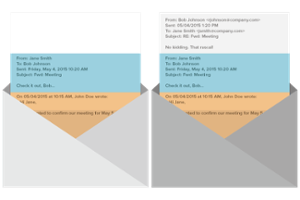Of all the text analytics tools available for e-discovery today, email threading is one of the quickest wins. Simply by organizing emails in their data by conversation, case teams can significantly reduce the reviewable set—saving thousands of review hours and dollars.
When you’re facing a review of a data set with a considerable number of emails, threading the conversations contributes even more organizational and time-saving benefits than you might think. Here’s how.
1. It’s a powerful complement to near-duplicate detection.
When you combine the duplicate analysis you’re already doing with email threading, you can organize and identify duplicate emails in your data in one motion. Depending on the use case, it may also be most efficient to run near-duplicate detection together with email threading—that way, in one swoop you can quickly streamline both the emails and other data types in your set.
2. It’s a way to batch out emails to reviewers consistently.
Once your emails are threaded, you’ll have a much easier time giving reviewers logical batches of documents to review, and your review will go faster. Use your email threads to send whole conversations instead of parsed, random emails. By following full conversations instead of reading bits and pieces, your reviewers can code their batches more confidently and consistently—saving you QC work down the road.
3. There’s more than one way to see threaded emails.
You can choose to display threaded emails as inclusives only—so only the messages that include unique content, or a full record of the conversation—or show entire threads, just as you’d see them in your inbox. Admins often like to see only inclusives for QC purposes, whereas reviewers may prefer to see the context of the full conversation. You can do both, so everyone on the team has an efficient environment in which to do their job.
4. There’s more than one way to produce threaded emails.
Depending on your case and production agreements with the opposing side, you may need to produce either entire email threads or inclusives only. Have this conversation during your meet and confer discussions to ensure the requirements are clear, but fear not: either option is possible, so you can accommodate the unique needs of each case. Producing entire threads is a similar workflow to producing with document families. As with any production, ensure you run a conflict check for privilege against all potentially outgoing documents.
5. Threading opposing counsel’s production is a time saver, too.
Although the Bates numbers stamped on the documents provided in opposing counsel’s production could normally lead to incorrect results with false inclusives, you can use regular expressions (via repeated content filters) in your analytics index to strip out those number patterns from the text of the produced documents. From there, you’ll see cleaner thread identification and groupings—and take advantage of the same time and cost savings you saw in your initial review—when you’re reviewing the other side’s produced documents to build your case.
What’s your greatest success story with email threading? Hear how Troutman Sanders saved their clients $233,000 in review costs simply by using email threading on their data set.










